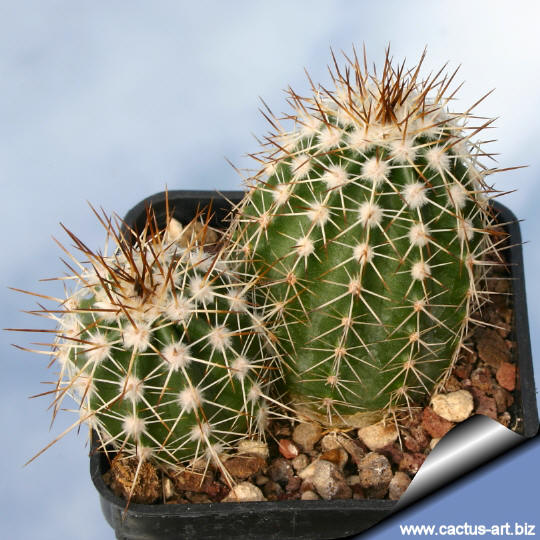|
Family:
Cactaceae (Cactus
Family)
Scientific name: Echinocereus
stoloniferus ssp. tayopensis (W.T.Marshall) N.P.Taylor 1997
Origin: Mexico (Eastern Sonora, Western Chihuahua)
Habitat: Open forest, desert grassland,
oak woodland transition areas.
Conservation status: Listed in
CITES appendix 2.
Synonyms:
- Echinocereus tayopensis W.T.
Marshall
- Echinocereus stoloniferus var. tayopensis
(W.T.Marshall) N.P.Taylor 1985
- Echinocereus stoloniferus subsp.
tayopensis (W.T. Marshall) G. Pichler In:
Repertorium Plantarum Succulentarum 45: 9. 1994[1995]. (Repert. Pl.
Succ.)
- Echinocereus stoloniferus
W.T. Marshal 1938
Common Names include: Biznaguita (Mexico)
|
|
Description: Clumping plant
propagating using underground stolons, that forms large colonies of
stems partly obscured by spines.
Stem: Upright, ovoid to cylindrical, slightly tapering toward the
apex, ribbed, greyish-green to olive-green up to 15 cm tall, 6-8 cm in
diameter.
Ribs: 14-16 ,
low and slightly tuberculated.
Areoles: Round to slightly elliptical, close
set, 5 mm apart, the young ones
have abundant white or brownish wool.
Central spines: 3 to 5 acicular, stiff
and straight, one longer, up to
2,5-3 cm long, pointing downward in the lower part of the areole,
usually brownish (or reddish, blackish or greyish).
Radial spines: 10 to 12, flattened against the stem up to 1,5 cm
long darker at the tip.
Flowers: Sub-apical, short funnel-form, bright, showy yellow or
whitish often turning pinkish on second day, up to 7,5 cm long and 7-10
cm in diameter.
Blooming season: Late spring, May-June.
Fruits: Red, very spiny.
|
|

Note:
Echinocereus stoloniferus steadily produces secondary
growths by means of underground or surface
stolons (like Agave, Sempervivum, etc.)
and forms rapidly large clumps.
Subspecies:
- E. stoloniferus subsp
stolonifereus: Stem cylindrical up to 30 (or more) cm tall, 5
cm in diameter with 6 radial spines. Origin. South-eastern Sonora.
- E. stoloniferus subsp.
tayopensis: Characterized by stems ovoid to shortly
cylindrical stems that only get up to 15 cm tall and 6-8 cm in
diameter, radial spines up to 15 mm long. Origin: Eastern Sonora,
Western Chihuahua.
Cultivation: In culture
E. stoloniferus is without problems and regularly shows its
beautiful flowers, if provided
with an adequate winter rest period. It is
sensitive to over-watering (rot prone),
and needs good drainage. Keep
drier and cool in winter. It needs
to be kept in a cool place during winter rest
Without this cool winter period they normally wont get many
buds.
Relatively cold resistant, (can
briefly tolerate temp. as low as -7°C)
Stems may possibly become purple and limp in winter but revitalize in
early spring.
Propagation: Seed, but the
as stems of this cactus branches readily and soon forms a mass of shoots
the simplest way to propagate it is to cut a piece of a
stem (or of a
stolon) in summer,
let it dry for a couple of days, and pot it up.
|